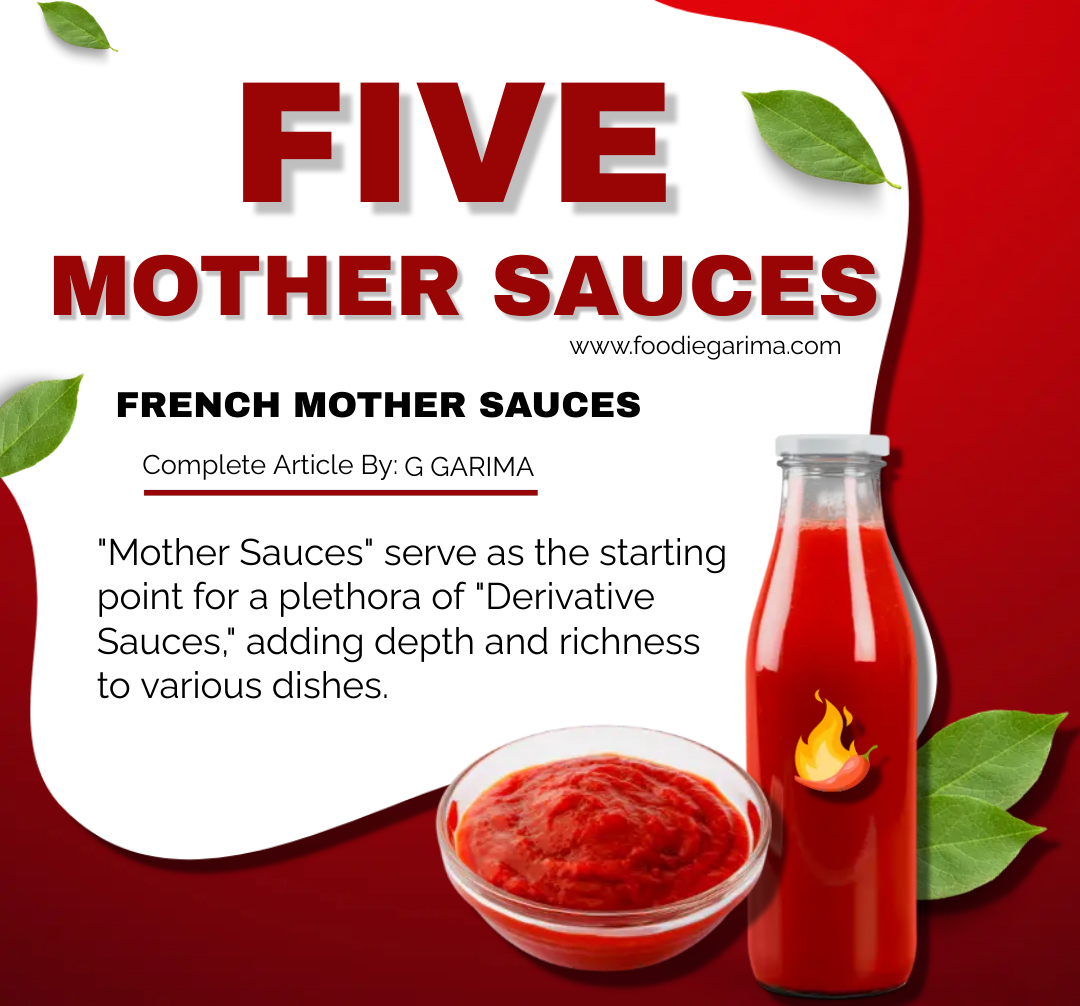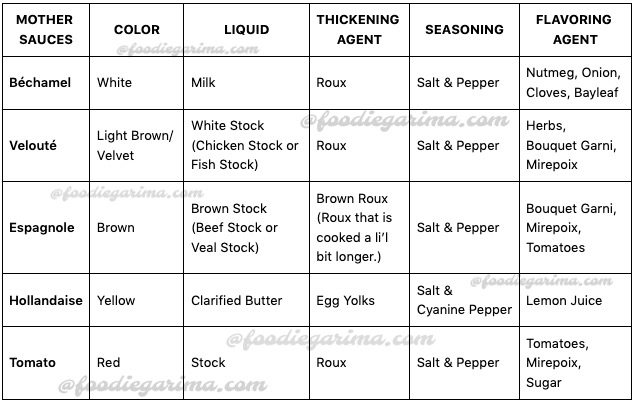13 February, 2023
FIVE MOTHER SAUCES | French Cuisine

Five Mother Sauces: The Backbone of Culinary Mastery
Welcome to the heart of the culinary world, where flavors harmonize and dishes come to life – the realm of the “Five Mother Sauces” or the “Basic Sauces.” These foundational sauces form the basis of countless culinary creations, offering Chefs a versatile platform to shape their gastronomic masterpieces.
In this article, we’ll delve into the Origins, Characteristics, and Culinary Importance of these sauces that have stood the test of time.
What is a Sauce?
A Sauce is a liquid, cream, or semi-solid (thick-liquid) substance that enhances the flavor, texture, visual appeal of a dish and also provides moisture to food. Typically, Sauces are prepared by combining a “Liquid Base,” with a “Thickening Agent,” such as Roux (a mixture of Flour and Fat) or Cornstarch, along with various “Flavoring Agents” like Herbs, and Spices.
Sauces create a complementary accompaniment to elevate the taste of the main components of a meal. These sauces can vary widely in consistency, ranging from thick and creamy to light and brothy, and they play a crucial role in defining the overall texture and appeal of the food.
What Are “Mother Sauces”?
“Mother Sauces” are the “Foundational Sauces” in classical French cuisine. They serve as the starting point for a plethora of “Derivative Sauces,” adding depth and richness to various dishes.
The term “Mother Sauces” is aptly used because each of these Sauces serves as the head or foundation of its own unique family or derivatives.
The distinction among the Mother Sauces lies in the specific Liquids and Thickeners used in their preparation. Typically made with a combination of Flour, Fat, and Liquid, these Sauces are seasoned and flavored in various ways to give rise to a diverse array of other Sauces.
Who Invented “Mother Sauces” ?
In the early 19th Century, the renowned Chef “Marie-Antoine Carême” codified the four original Mother Sauces, laying the foundation for classical French cuisine.
- Béchamel
- Velouté
- Espagnole
- Allemande
Later on, French Chef “Auguste Escoffier,” another culinary luminary, reclassified the Mother Sauces and solidified the concept of the Five Mother Sauces that are widely recognized today.
He reclassified “Allemande” as a “Daughter Sauce” or variation of “Velouté“, thus excluding it from the classification of “Mother Sauces.” Additionally, Chef Escoffier introduced two new Sauces “Tomato Sauce” and “Hollandaise Sauce” to the classification, ultimately establishing the widely recognized “Five Mother Sauces” that form the basis of classical French cuisine.
This modification solidified the framework for countless culinary creations and became a cornerstone in the world of cooking.
Five Mother Sauces:
- Béchamel Sauce
- Velouté Sauce
- Espagnole Sauce
- Hollandaise Sauce
- Tomato Sauce
Easy Classification:

Characteristics of Each Mother Sauce
- Ingredients: Each Mother Sauce boasts a distinct set of ingredients, contributing to its unique flavor profile. Understanding these components is key to mastering the art of sauce-making.
- Preparation Techniques: From Roux-based thickening to emulsification, the preparation techniques for each Mother Sauce vary. Attention to detail is crucial for achieving the desired consistency and flavor.
- Common Uses: The versatility of Mother Sauces lies in their ability to complement an array of dishes. Whether as a base, drizzle, or accompaniment, these Sauces play a vital role in culinary creations.
Three Compositions of Sauces:
- Liquid
- Thickening Agent
- Flavoring or Seasoning Agent
1. Béchamel Sauce: (Milk + Roux)
- Also known as “White Sauce”
- Milk + Roux (Roux explained below)
Béchamel Sauce Composition:
- Liquid: Hot Milk
- Thickening Agent: White Roux (1 Part of Flour + 1 Part of Fat)
- Flavoring or Seasoning Agents: Season with Nutmeg, Onion, Cloves, Bayleaf, Cheese for additional flavor.
What is “ROUX” ?
“Roux” is a cooked mixture of equal parts of “Flour” and “Fat” in the ratio of (1:1), that serves as a “Thickening Agent” in various Sauces, Soups, and Gravies.
“Roux” = Flour + Fat
To make Roux, equal parts of Flour and Fat are combined and cooked together over heat. The cooking process eliminates the raw taste of the flour and imparts a nutty flavor to the Roux.
Facts of Béchamel Sauce:
- Béchamel is similar to its sister sauce Velouté. The only difference is Béchamel is milk based and Velouté is liquid/ stock based.
- Béchamel’s meticulous preparation involves creating a Roux and gradually incorporating the Milk by constantly stirring for a lump-free sauce. Achieving the ideal consistency and flavor involves precise measurements and attentive cooking.
- Simplest of the mother sauces because it doesn’t require Stock.
- Usage: Béchamel’s versatility shines in dishes like Lasagna, Macaroni and Cheese, Cheese Sauce, and Creamy Soups. Its ability to blend seamlessly with other flavors makes it a culinary essential.
To Know Béchamel Sauce Derivatives, Click This Link https://foodiegarima.com/derivatives-of-bechamel-sauce/
.
.
2. Velouté Sauce: (Light Stock + Roux)
- This is a “White Sauce” with a Blonde or Light Brown color. This has a Velvety and Smooth Texture
- White Stock + Roux
- White Stock: Chicken and Fish (basically chicken Stock)
- White Stock of Chicken for Chicken Velouté and White Stock of Fish for Fish Velouté. Don’t cook Fish Velouté for more than 20 mins and add wine to it at a later stage.
Velouté Sauce Composition:
- Liquid: White Stock
- Thickening Agent: White or Blonde Roux
- Flavoring or Seasoning Agents: Herbs, Bouquet Garni, Mirepoix
Facts of Velouté Sauce:
- Velouté is considered Savoury Sauce because of the Stock in it.
- The term Velouté means Velvety in French.
- Velouté is considered as a lighter alternative to the richer Espagnole Sauce.
For Velouté Sauce Derivatives, Click This Link https://foodiegarima.com/veloute-sauce-derivatives/
.
What is “STOCK” ?
Stock refers to a flavorful liquid, technically a “water extract” that is created by simmering animal bones, meat, vegetables, and aromatic spices in water. The goal of making Stock is to extract and concentrate the flavors, nutrients from the ingredients, resulting in a versatile and savory base for Soups, Sauces, and various Dishes.
What is “BOUQUET GARNI” ?
A Bouquet Garni is a bundle of herbs, typically tied together with string or enclosed in a muslin cloth, used to infuse flavor into soups, stews, stocks, casseroles and various dishes.
Herbs used: Parsley, Bayleaf and Thyme
What is “MIREPOIX” ?
A Mirepoix is a French flavor base made from a combination of diced vegetables (Onions + Celery + Carrots) by lightly cooking them.
Onion : Celery : Carrots = 2:1:1
.
3. Espagnole Sauce: (Brown Stock + Brown Roux + Mirepoix)
- Also known as “Brown Sauce”
- Brown Stock + Brown Roux + Mirepoix
- Brown Stock: Beef Stock or Veal Stock
- For Brown Stock, bones have first been roasted to add color and flavor.
- Brown Roux is Roux that is cooked a li’l bit longer.
Espagnole Sauce Composition:
- Liquid: Brown Stock (Beef Stock or Veal Stock)
- Thickening Agent: Brown Roux
- Flavoring or Seasoning Agents: Bayleaf, Parsley, Mirepoix, Tomato Puree
Facts of Espagnole Sauce:
- Espagnole Sauce is the thickest and beefiest Sauce of all the Mother Sauces as its main ingredient is Beef Stock. It has a strong taste and is a more complex mother sauce.
To Know Espagnole Sauce Derivatives, Click This Link https://foodiegarima.com/espagnole-sauce-derivatives/
4. Hollandaise Sauce: (Clarified Butter + Warm Egg Yolks + Emulsification Process)
- Also known as “Emulsified Sauce” or “Tangy Buttery Sauce”, “Yellow” in color.
- Clarified Butter + Warm Egg Yolks (Slowly whisk the clarified butter into warm egg yolks for a smooth creamy texture).
Hollandaise Sauce Composition:
- Liquid: Clarified Butter
- Thickening Agent: Egg Yolks
- Flavoring or Seasoning Agents: Cyanine Pepper and Lemon Juice
Facts of Hollandaise Sauce:
- Hollandaise Sauce is also called ‘Dutch Sauce’. Despite its name, it is not of Dutch origin but rather a French creation.
- Its preparation takes a long time as it involves emulsification.
- This Sauce is protein rich because of egg yolk in it. So keep it in the refrigerator as it catches the bacteria at high temperature.
- This is similar to Mayonnaise and both contain a high percentage of fat.
To Know Hollandaise Sauce Derivatives, Click This Link https://foodiegarima.com/hollandaise-sauce-derivativve/
.
What Is Clarified Butter?
Clarified Butter is a form of Butter from which Water and Milk Solids have been removed, leaving behind pure Liquid Fat.
.
5. Tomato Sauce: (Tomatoes + Stock + Mirepoix)
- Also known as “Red Sauce” or “Tomate”
- Tomatoes + Stock + Mirepoix (Onions, Celery, Carrots)
- Cook the tomatoes, onions and peppers in Chicken Stock or Vegetable Stock until reduced to a thick texture.
- Mix this Tomato Sauce with Butter Roux and use in dishes like Pastas.
- Anything French cooking, any French recipe, if they call for chopped tomatoes it is usually without the skin
Tomato Sauce Composition:
- Liquid: Beef Stock
- Thickening Agent: Butter Roux
- Flavoring or Seasoning Agents: Bayleaf, Thyme, Sugar, Pepper
Culinary Applications of Tomato Sauce:
- Tomato Sauce is the base of Mexican Salsas, and Sauce for Pizza and Pasta dishes.
To Know Tomato Sauce Derivatives, Click This Link https://foodiegarima.com/tomato-sauce-derivatives/
Mastering the art of Mother Sauces is a rite of passage for any aspiring chef. These Sauces not only provide a solid foundation but also unlock the door to culinary creativity.